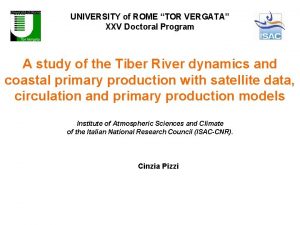University of Rome Tor Vergata https www fisica



- Slides: 3

University of Rome Tor Vergata https: //www. fisica. uniroma 2. it/solare F. Berrilli, M. Casolino, D. Del Moro, L. Giovannelli, R. Forte, M. Lovric, M. Martucci, M. Mergè, L. Narici, V. Penza, G. Pucacco, F. Pucci, A. Rizzo, S. Scardigli, R. Sparvoli Main Projects: FP 7 -EST, FP 7 -SOLARNET, H 2020 -GREST, EU-REACT-SPARC, EU-Ionosphere Prediction Service, PAMELA, ALTEA, CSES Activity: Solar Dynamics and Activity, Sun-Earth interaction, Space Weather, Improve tools for solar synoptic observations and particle detection. CSES satellite hosts several instruments onboard: 2 magnetometers, an electrical field detector (EFD), a plasma analyzer, a Langmiur probe and a High Energy Particle Detector. PAMELA satellite in orbit since 2006 Magneto Optical filters at Two Heights (MOTH) instrument – Hawaii (USA) + Europe: K (770 nm), Na ( 589 nm). Soon: He (1083 nm). Future: Ca (422 nm) - Simultaneous LOS data

PAMELA & CSES (INFN Coll. ) University of Rome Tor Vergata - Detection of charged cosmic rays of galactic, solar and trapped origin - Differential flux reconstruction - Particle intensities continuous monitoring in time CSES Measurements Instruments Measurement of the electrical Search-Coil Magnetometer Fluxgate Magnetometer and magnetic fields and their Electrical Field Detector perturbations in ionosphere (CHN/ITA) Plasma analizer Measurement of the disturbance of plasma in Langmuir probe ionosphere Measurement of the flux and High Energy Particle Detector energy spectrum of the (ITA) particles in the radiation belts Measurement of the profile of electronic content GPS Occultation Receiver Tri-frequency transmitter Particle count rates SEPs detected so far SEP-analysis issues: • Source identification & classification Association to flares, CMEs… • GLEs Different class of events? • Spectra evolution Intensity, time profile , spectral signatures… • Composition p/He, 3 He content… • Magnetospheric effects

Flare forecasting University of Rome Tor Vergata Automated Solar Flare Forecasting with multiline MOTH synoptic magnetograms Full disk multiline LOS magnetic and velocity maps every minute with flare probability parameter evaluated using temporal evolution and geometry of Bipolar Active Regions and B field distribution and stength (June 2016). Main focus: reduce the multiline maps of the observed magnetic field to a handful of parameters characterizing the active region’s size, time evolution, energy, polarity inversion lines. Forecasting technique based on Bipolar Active Regions big enough to host current sheets and enough magnetic Energy E=B 2 /(8 π)∗L 3 MOTH instrument is able to evaluate both horizontal x, y BLOS and vertical magnetic z. BLOS gradients, Dopplergrams (i. e. , VLOS images) and intensity images. Line-of-Sight approximation of vector magnetogram LOSWLSG= ( BLOS)dl integration is along strong-field intervals of the AR neutral lines.





